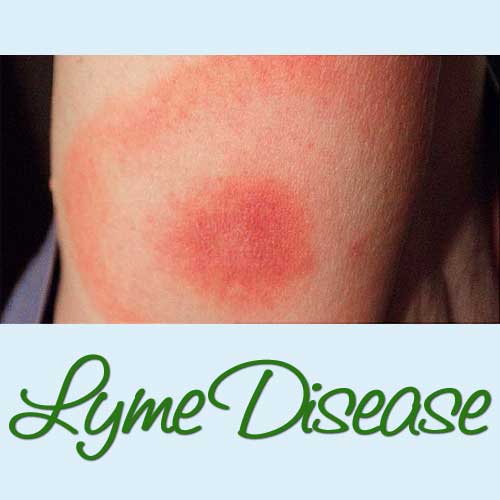Being outside, carefree, full of energy rolling around in the grass, throwing leaves at each other, laughing you would never guess that you may need to be careful and aware of what may bite you. Ticks. They are in the grass, the dirt, trees, everywhere outside and many of them carry diseases; one of those disease is Lyme Disease.
Ticks are found in all 50 states and when you get bitten by one you need to get it off your skin right away or suffer dire consequences. Ticks are an Arachnida type of insect. That is they belong in the spider family. Ticks require blood to complete their life cycle. There are 800 different types of ticks. They have been around for 90 million years. There are two different types of ticks Iodidae and Argasida. Iodidae are hard body ticks and they don’t carry diseases. Argasida are soft body ticks and they transmit diseases to humans.
Lyme disease was discovered in 1975 in Old Lyme Connecticut when a doctor couldn’t understand why his patient was getting sick and then he discovered that the patient was bitten by a tick. There are 23,558 people who get Lyme disease every year. Lyme disease mainly affects males who are hunters or hikers who are constantly outside between the ages of 15 and 60 years old.
Lyme disease is caused by the bacterium borelia burgdoriferi found in the softy body ticks like deer ticks or black legged ticks. Humans get it through a bite.
Symptoms of Lyme Disease:
- Fever
- Headache
- Fatigue
- Skin rash that is oval shaped.
It takes 36 hours for the tick that has not been removed from the human to infect them.
When a tick bite goes untreated or is not removed it affects:
- Joints
- The heart
- Nervous system
- The eyes
It is vital that you go to the doctor right away after being bitten by a tick and also to remove a tick from your body. The doctor will prescribe you antibiotics. If you don’t get treatment it leads to more serious complications and could be a life long thing.
Here is how you can remove a tick:
- Wear hand protection such as gloves so you don’t spread pathogens from the tick to your hands; use a fine-tipped forceps or tweezers to grab the tick at skin level.
- Grasp the tick firmly with the tweezers as close to the skin as possible without crushing the tick. Apply gentle pulling motion upward until the tick comes free. Twisting or turning the tick does not make removal easier because the mouthparts are barbed; in fact, such actions may break off the head and mouthparts, thereby increasing the chances for infection. Click Here to see Proper Removal of a Tick.
- Once the tick is removed, don’t crush the tick because it may release pathogens. Consider keeping it in a tightly closed jar or taped to a piece of paper. Show the tick to the doctor if the person bitten becomes ill after the tick bite. Flush any removed ticks not kept for identification down the toilet or sink.
- The area of the bite should leave a small crater or indentation where the head and mouthparts were embedded. If portions of the head or mouth parts remain, they may be removed by a doctor.
- Thoroughly cleanse the bite area with soap and water or a mild disinfectant. Observe the area for several days for development of a reaction to the bite (rash or signs of infection). Apply antibiotic cream to the area as a precaution. Application of an antibiotic to the area may help prevent a local infection but usually does not affect the chance of developing diseases transmitted by the tick.
- Wash hands thoroughly after handling any tick or instruments that touched a tick. Clean and disinfect any instruments that were used.
Here is how you prevent being bitten:
- Cover up when going into the woods
- Tick proof your yard
- Check yourself, your clothing
- Do not assume you are immune to being bitten
- Remove ticks after you are bitten immediately and go to your doctor.
Lyme disease is a horrible illness and one we can prevent by being aware of ticks in our yards and woods and removing them quickly once bitten.
If you would like help with creating a wellness plan, Karen G Clemenson and the Wellness Work NW Team would be happy to assist you in creating a plan that is right for you. Check out WWNW’s Youtube Channel for exercise ideas and information.
Here are some links I would like to share with you:
- Everything You Need to Know About Lyme Disease by Healthline Editorial Team and medically reviewed by Cameron White, MD, MPH
- Lyme Disease by Centers for Disease Control and Prevention Staff
- Lyme disease by Mayo Clinic Staff
- Ticks (Tick Bites) by Charles Patrick Davis, MD, PhD and edited by Jerry R Balentine, DO, FACEP for MedicineNet
- Tick Removal and testing by Centers for Disease Control and Prevention Staff
- Photo Credit: Lyme Disease: Important Facts to Know by WebMD Staff
Related Articles:
To look for a particular topic please see our Healthy Living Blogs page. If you don’t find what you are looking for please click on the button below to fill out a request form and someone from Our Team will be glad to research it for you for FREE!
 Jamie Holloway is a co-owner of Wellness Works NW and she is also our Research Manager and writes our Chasing Wellness with Jamie Holloway and Dear Jamie columns. Jamie is also an Independent Wellness Advocate at dōTERRA. She lives in the Portland, Oregon area. Since October 2011 she has been sharing her Journey Toward Health and Wellness with Vasculitis through her blog at JamieChasesButterflies.com. We hope you are as inspired as we are with the raw candor Jamie uses in her writing. If you would like to help support Jamie’s writing efforts please Donate now.
Jamie Holloway is a co-owner of Wellness Works NW and she is also our Research Manager and writes our Chasing Wellness with Jamie Holloway and Dear Jamie columns. Jamie is also an Independent Wellness Advocate at dōTERRA. She lives in the Portland, Oregon area. Since October 2011 she has been sharing her Journey Toward Health and Wellness with Vasculitis through her blog at JamieChasesButterflies.com. We hope you are as inspired as we are with the raw candor Jamie uses in her writing. If you would like to help support Jamie’s writing efforts please Donate now.













